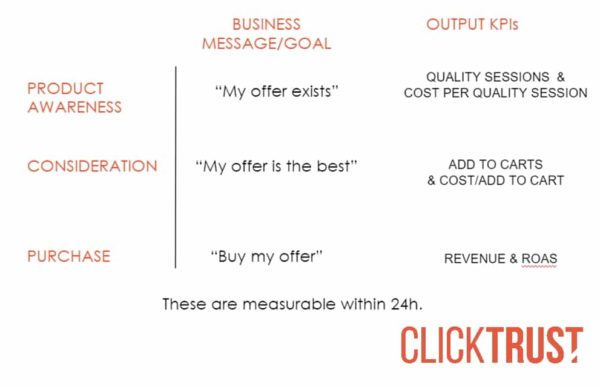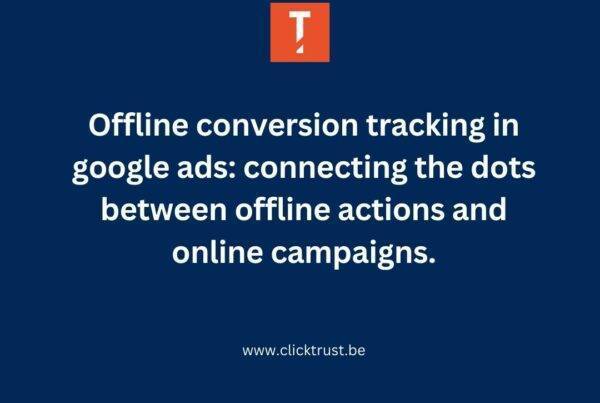Measuring the impact of digital campaigns is complex. It becomes even harder when you’re a small business wanting to sell online through your e-shop. Seeing the spending increase without having a direct impact on sales may be frightening. This is exactly what happened to one of our clients, Twistiti, a small Belgian company selling educational watches to teach children how to grasp the concept of time.
When we first met the owner, he was clueless and didn’t know where to start. He wasn’t convinced about the real added value of digital advertising on his online sales. He tested several awareness campaigns in the past, but as soon as the cost per sale was increasing or the sales volume was not following the same path as the increase in the budget allocated to media, the first reaction was to stop the campaigns right away to avoid spending without an immediate return on investment.
Digital marketing doesn’t work that way, it’s way more fragmented. You’d be a fool if you expect a direct response from an awareness campaign without considering your customer journey holistically and the fundamental behavior of an online buyer. Investing in one channel doesn’t mean you’ll see all your return coming from that channel.
Looking into past data to determine what the journey of your customer is
As an online shopping enthusiast, I often compare products to find the one that suits me the best. Once I’ve found what I want, I compare different webshops to find the best place where I can buy my precious item. I sometimes buy it at that moment, sometimes keep it in mind to buy the product when I need it. This is common behavior of an online user, and even more so since the pandemic.
Looking for a product online doesn’t mean immediately buying it for the reasons mentioned here above. The same goes for every single step in the customer journey.
We started by digging into past data to analyze the impact of awareness campaigns. The majority of the investment was made on upper-funnel channels, while they were only delivering 6% of the sales (measured in Google Analytics).
While we could easily understand why a small brand like Twistiti, with limited media budget, could hit the stop button looking at these kinds of figures, it doesn’t paint the full picture. Indeed, evaluating those campaigns on a Last Non-Direct Click attribution model (used in Google Analytics) limits our vision on global performance. With the cookie lifetime being reduced (GDPR, ITP, ETP, or simply users deleting their cookies), how can we expect to be able to measure the impact of campaigns on such end-of-funnel conversions, especially when talking about long customer journeys? To learn more about this topic, we recommend you to read Fabian’s article on measuring digital campaign performance.
When digging deeper, we realized those same channels were actually generating more than a third of all the add-to-carts on the eshop. Basically, users were interested, they added to their cart to come back after some time or look for other marketplaces to buy it. Considering the reduced lifetime of cookies, no attribution model will give credit to your campaigns, as the analytics won’t be able to retrace the entire customer journey, and will thus undervalue your campaign channels. This is mainly true for Safari and Firefox users with their built-in restrictions deleting 1st party cookies after 7 days or 1 day in certain conditions but is also valid for chrome users impacted by GDPR and users deleting their cookies.
It reveals the importance of determining the right KPI to assess the performance of your upper-funnel campaign. Sales being too far away in the customer journey, a proxy KPI needs to be set, based on its relationship with that final conversion. For e-commerce, the website is often built this way: Product Page – Cart – Conversion Funnel – Sale. This exercise can obviously be applied to any kind of business. The goal is to find the deepest KPI that can be measured within 24h to counter browser restrictions and that can be used as a leading indicator for conversions at a later stage.

Once the correct KPI correlation has been determined, a correct value of each conversion needs to be calculated based on its relationship with the final sale, basically using the conversion rates between each step. If your desired cost per sale is 50€ and if you need 5 add-to-carts to have one sale, the target value of your ATC will be 10€. As simple as that.
Having a correct value for each step will be key in the optimization of your campaigns, as you know how far you can authorize the algorithms to go. This information allows you to drive media budgets between channels and play with them to reach your cost-per-conversion goals. You can even go further and apply value-based bidding using a tROAS where possible to take into account every step of your conversion funnel and tell the bidding how important are the steps to your business for him to maximize the revenue.
A holistic approach to measuring results
Measurement has had very hard times in recent years. Being able to measure channel by channel with a last-click attribution model is over. We need to break the silos and need to look at the full picture.
If you don’t, you will under-invest in consideration driving campaigns as “they never convert” and start over-investing in lower-funnel touchpoints (often branded search and retargeting) as they get the credit by cookie-based attribution. It is then impossible to scale up as you’re blocking new acquisition focussing on people that already know you or have already taken their decision to buy from you.
A holistic approach is thus required to assess all your marketing efforts and to avoid undervaluing your digital campaigns. Each channel has its own role in your customer journey and will impact all the other, paid and non-paid traffic sources. Monitoring a global cost per sale will help to guarantee that you keep investing in the channels driving revenue or will give you the information you’ll have to tweak your budgets to stay close to your objective.
Don’t forget the other marketplaces! Users have their consumption habits. They are curious about a product they saw online and look for it in places they trust. For our client Twistiti, as soon as awareness campaigns were launched, an increase in Amazon sales was spotted. Not considering those sales would imply you’re putting aside part of your data and undervaluing all your upper-funnel marketing efforts.
Results of our approach: the volume of digital sales increased by 1500% at the end of 2020 compared to the year before. Even though part of this success may be attributed to the lockdown, figures in January 2021 were still excellent with a 10X increase in sales compared to January 2020, before the Covid pandemic hit.
Going further
This is just the starting point. If you’re a larger company, with larger media budgets including offline media, you’ll have to go further to assess the impact of each channel you’re activating on your campaigns.
There are several solutions that can help you understand if your media mix is correct and if your budgets are invested in the right way thanks to media mix modeling for instance, with the use of statistical models analyzing the impact of the media investment on your revenue or to calculate the ideal budget you need to invest on each channel.
There are also ways to predict sales and model final conversions based on micro-conversions using clean data and machine learning.
Want to know more? Make sure to read Fabian’s article on measuring digital campaign success.
Let’s sum up
1/ Understand your customer journey to define the right KPIs. Your past data is gold. Map out your customer behavior and assess all the KPIs based on their relationship with the final sale/conversion that you can use as leverage for scaling up. With the cookie’s death, you’ll need to stop evaluating your upper-funnel campaigns on the final sale and start optimizing towards a correspondent KPI measurable within 24h, like product view or add to carts.
2/ Get ready for seasonality. Even if you’re in a situation where your product is sold mainly during a certain period of time, users look for your product all year long. Keep your presence always on, as long as you maintain all your KPIs at the predetermined value. Tease your audience, and keep in contact with your users. When it’s time, they will come back and convert.
3/ Break the silos and measure your results holistically. Upper-funnel channels will have an impact on the other traffic sources and other marketplaces. Measuring them globally using micro-conversions or proxy KPIs like product views or add-to-carts will give you a complete picture of the performances of your marketing efforts and guarantee you’re not undervaluing your awareness and consideration campaigns. To take it further, data science can be used to model cross channels sales based on these micro-conversions, but we’ll explain how to do that in an upcoming post.
Ontvang onze inzichten rechtstreeks in je inbox
We duiken regelmatig in actuele onderwerpen op het gebied van digitale marketing en delen onze inzichten graag met jou.

